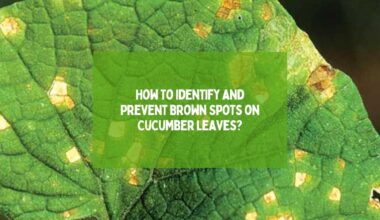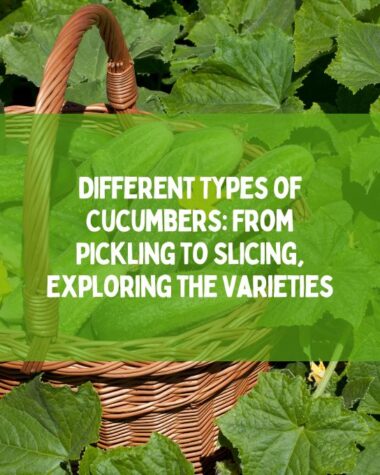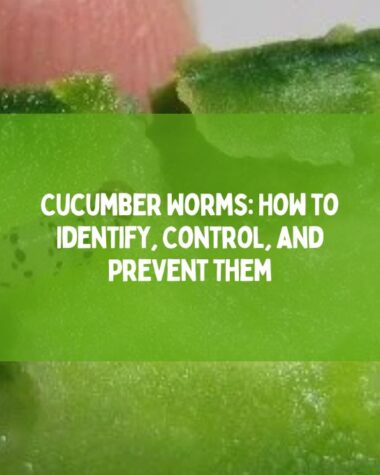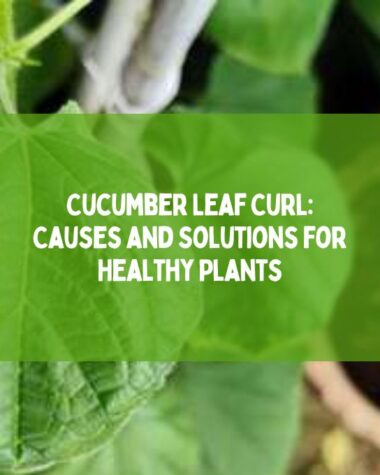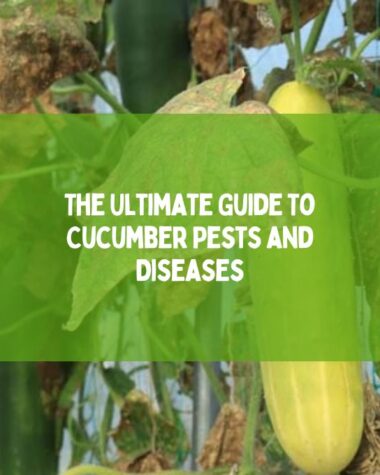White spots on cucumber plants can be caused by a variety of factors, including pest damage, fungal infections, sun scalding, nutrient deficiencies, and environmental stress.
Cucumbers are a popular vegetable that is widely grown and consumed around the world. Cucumbers are low in calories and high in water content, making them a refreshing and hydrating snack. They are also a good source of vitamins C and K and contain small amounts of other nutrients such as potassium and fiber.
Cucumbers are relatively easy to grow and can be grown in a variety of settings, including home gardens and containers.
In this article, we are specifically diving into the causes and prevention of white spots on cucumber plants. How do you recognize them? and immediate actions you should take to cease them.
Let’s get it!
5 Main Reasons For White Spots On Cucumber Plants

If you’re unsure about the cause of the white spots, it’s best to consult a gardening expert or plant pathologist for a diagnosis and treatment recommendations. Take prompt action to stop the problem from spreading and perhaps causing further harm if you see any white patches or other signs on your cucumber plants.
There are several reasons why cucumber plants could develop white patches. Following are some of the most typical causes and some advice for avoiding them:
1. Powdery Mildew in Cucumbers

Since this fungus prefers warm, humid weather, it is a frequent issue for cucumber plants. The fungus’s spores are what are causing the white, powdery areas. In addition to the powdery covering, fruit, and foliage may develop yellowing or distortion.
As previously noted, powdery mildew may be avoided by avoiding overhead watering and allowing proper air circulation. A fungicide treatment can aid in the control of the illness if it has already manifested.
Prevention:
Here are some steps you can take to prevent and treat powdery mildew on your cucumber plants:
- Pick resistant varieties: When pickling cucumber varieties, opt for those that are powdery mildew resistant. Dasher II, Marketmore 76, and Straight Eight are a few types of cucumber that are resistant to powdery mildew. Make sure there is adequate air movement around your cucumber plants to stave off powdery mildew.
- Avoid overhead watering, since this might encourage the establishment of powdery mildew. Instead, water the plant from the bottom up. Instead, use a soaker hose or drip irrigation system to water your cucumber plants at the base of the plant. Plant material that has been affected should be removed from the plant and properly disposed of, such as any leaves or stems that have powdery mildew. This will aid in halting the spread of the illness.
- Apply fungicides: Fungicides can be used to help control the disease if powdery mildew is already affecting your cucumber plants. For powdery mildew on cucumbers, typical fungicides include sulfur-based compounds and potassium bicarbonate.
Related Reading:
- Cucumber Worms: How to Identify, Control, and Prevent Them
- Bad Cucumbers – Symptoms, Prevention, and Side Effects
- Kheera, Cucumber, and Kakdi – Understanding the Differences
2. Sun scaling In Cucumbers

This is a condition that occurs when the fruit is exposed to too much sun, causing it to become discolored or white in spots. Sunscald can happen when the leaves of the plant do not provide enough shade for the fruit.
Prevention:
To prevent sunscald, make sure your plants have enough foliage to provide shade and avoid leaving fruit exposed to direct sunlight for extended periods of time.
Here are some of the steps you can take to stop or prevent the sun from scalding cucumbers:
- Provide shade: To prevent sun scalding, make sure your cucumber plants are adequately shaded. You can provide shade by growing your cucumbers under a trellis or other structure that provides partial shade. You can also use shade cloth or other materials to provide additional shading.
- Maintain healthy foliage: Healthy foliage can provide natural shade for the fruit. Make sure to keep the leaves of your cucumber plants healthy and well-hydrated by providing adequate water and nutrients.
- Use reflective mulch. Reflective mulch can help prevent sun scalding by reflecting light away from the fruit. You can use aluminum foil or reflective plastic mulch to achieve this effect.
3. Pest Damage to Plants

Certain cucumber pests, such as spider mites and whiteflies, can cause white spots on cucumber plants. Other signs, like yellowing foliage or deformed fruit, may also appear along with these spots.
Prevention:
To prevent pest damage, use insecticidal soap or other natural pest control methods, and make sure to keep your plants healthy and well-nourished.
Here are some of the most common pests that affect cucumber plants and how to identify and treat them:
- Cucumber beetles: These beetles are yellowish-green with black stripes or spots and can cause damage to the leaves and flowers of the cucumber plant. They also transmit bacterial wilt disease, which can be fatal to the plant. To control cucumber beetles, use row covers to prevent adult beetles from laying eggs on the plant, and remove any beetles by hand.
- Aphids: Aphids are small, soft-bodied insects that can cause yellowing of the leaves and stunt the growth of the plant. They can also transmit viruses to the plant. To control aphids, spray the plants with a strong stream of water to knock them off, or use insecticidal soap.
- Spider mites: Although these small pests might be hard to spot, they can cause leaf yellowing and webbing. They are more prevalent in hot, dry weather. Spraying water on the plants will make them more humid, and you may also apply neem oil to get rid of spider mites.
4. Nutrient deficiencies In Cucumber Plants
Cucumber plants require a balance of nutrients to grow and produce healthy fruit. If the plant is lacking in certain nutrients, it may develop white spots on the leaves or fruit. When a plant is lacking essential nutrients, it may not be able to produce enough chlorophyll, which is necessary for photosynthesis and the production of green pigments in leaves.
Common nutrient deficiencies in cucumber plants include nitrogen, potassium, and calcium. To prevent nutrient deficiencies, make sure to fertilize your plants regularly with a balanced fertilizer.
Here are some examples of nutrient deficiencies that can cause white spots on cucumber plants:
- Zinc deficiency: Zinc is essential for the synthesis of chlorophyll, and a deficiency can cause white spots on the leaves. Zinc-deficient plants may also have stunted growth and distorted leaves.
- Calcium deficiency: Calcium is essential for cell wall development, and a deficiency can cause the fruit to have white, sunken spots. Calcium-deficient plants may also have weak stems and distorted leaves.
- Iron deficiency: Iron is necessary for the production of chlorophyll, and a deficiency can cause white spots on the leaves. Iron-deficient plants may also have yellowing between the veins of the leaves.
5. Environmental Stress in Plants

Environmental stress can cause white spots on cucumber plants by disrupting their normal growth and development. Temperature stress, drought stress, excessive light exposure, and chemical exposure are some of the few factors known to cause environmental stress.
Prevention:
To prevent environmental stress from causing white spots on your cucumber plants, it’s important to monitor their growth and provide them with appropriate care. Make sure your plants are watered regularly and are not exposed to extreme temperatures or excessive light.
If you are using chemicals, be sure to follow the instructions carefully and apply them at the appropriate times. Additionally, you can provide shade or cover for your plants during extreme weather conditions to help protect them from stress.
By following these tips, you can help prevent white spots on your cucumber plants and keep them healthy and productive.
Related Reading:
- 10 Tomato Seedling Problems and How to Protect Them?
- The Ultimate Guide to Growing Pumpkins in Grow Bags: Tips, Techniques, and Best Practices
- 7 Reasons Why is my Zucchini Plant Not Producing Fruit?
- Understanding Deformed Carrots And How To Fix Them
- Top 5 Eggplant Growing Problems (and How to Fix Them)
Conclusion
It is important to identify the underlying cause of the white spots in order to take appropriate action and prevent further damage to the plants. Proper care, including regular watering, fertilizing, and monitoring for pests and diseases, can help prevent the formation of white spots on cucumber plants.
White spots on cucumber plants can be a cause for concern, as they can be an indication of problems that can ultimately affect the plant’s growth and production. If you keep a lookout for such problems and regularly put effort into preventing them, you will be assured of bountiful harvests of cucumbers.
If you notice any white spots or other symptoms on your plants, it’s important to take action quickly to prevent the issue from spreading and potentially causing more damage.
Thank you for reading!

